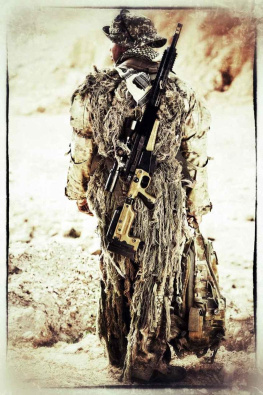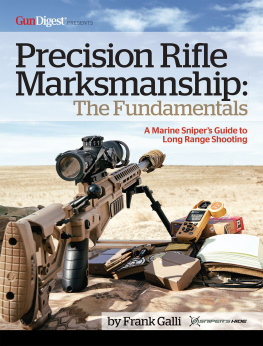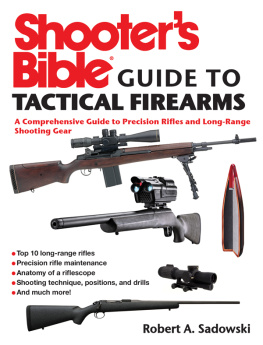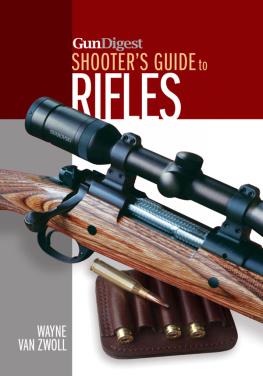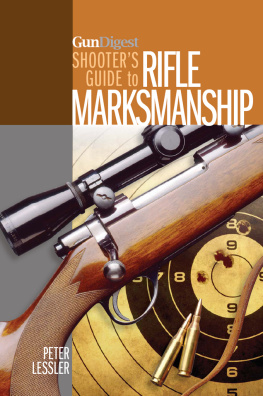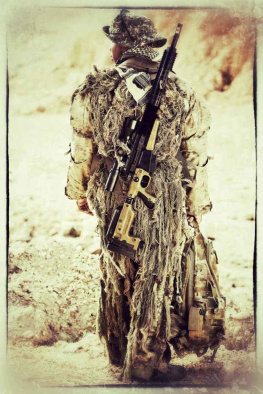Nicholas Irving - Precision Rifle B.I.B.L.E Volume 2
Here you can read online Nicholas Irving - Precision Rifle B.I.B.L.E Volume 2 full text of the book (entire story) in english for free. Download pdf and epub, get meaning, cover and reviews about this ebook. year: 2013, publisher: Nicholas G. Irving, genre: Romance novel. Description of the work, (preface) as well as reviews are available. Best literature library LitArk.com created for fans of good reading and offers a wide selection of genres:
Romance novel
Science fiction
Adventure
Detective
Science
History
Home and family
Prose
Art
Politics
Computer
Non-fiction
Religion
Business
Children
Humor
Choose a favorite category and find really read worthwhile books. Enjoy immersion in the world of imagination, feel the emotions of the characters or learn something new for yourself, make an fascinating discovery.
- Book:Precision Rifle B.I.B.L.E Volume 2
- Author:
- Publisher:Nicholas G. Irving
- Genre:
- Year:2013
- Rating:5 / 5
- Favourites:Add to favourites
- Your mark:
- 100
- 1
- 2
- 3
- 4
- 5
Precision Rifle B.I.B.L.E Volume 2: summary, description and annotation
We offer to read an annotation, description, summary or preface (depends on what the author of the book "Precision Rifle B.I.B.L.E Volume 2" wrote himself). If you haven't found the necessary information about the book — write in the comments, we will try to find it.
Precision Rifle B.I.B.L.E Volume 2 — read online for free the complete book (whole text) full work
Below is the text of the book, divided by pages. System saving the place of the last page read, allows you to conveniently read the book "Precision Rifle B.I.B.L.E Volume 2" online for free, without having to search again every time where you left off. Put a bookmark, and you can go to the page where you finished reading at any time.
Font size:
Interval:
Bookmark:
Precision Rifle B.I.B.L.E
Volume 2
Nicholas G. Irving Nicholas G. Irving
Copyright 2012 Author Name All rights reserved.
ISBN:
ISBN-13:
Neither the author nor the publisher assumes any responsibility for the use or misuse of the information contained in this book. This information is also not a substitute for the one on one training that can be provided by a professional sniper instructor. DEDICATION
To the men of the 75th Ranger Regiment and Joint Special Operations Community who have served, are serving, and will to continue to serve leading the way. All the Way!!!
Contents
Woodland.............................................................................. 113
History of the Precision Shooter
Looking at the variations of rifles, optics, and tactics available to us in this day and age, we can see how precision shooting is becoming a growing past time and interest. During my time serving as a sniper in the United States Army Joint Special Operation Command, I learned that by understanding the history of precision shooting, I could better myself as a tactical shooter whether it is in combat or competition.
Realizing and understanding that precision shooting has come a long way over time and technology has greatly advanced, we can still learn from our past.
Sgt. Nicholas G. Irving (Reaper 33)
The Precision Shooter
Precision shooting started on September 19, 1777 at the battle of Saratogo, also known as the Battle of Freemans Farm, where the Colonists hid in the trees and used early model rifles to shoot British officers. The most notable shot taken, was the shot from Timothy Murphy, who killed General Simon Fraser on October 7, 1777 at a distance of 400 yards.
A 400 yard shot to us today may not seem that far, but lets acknowledge the fact that this skill set was relatively new, and looked at as a cowards way of fighting a war. There were no ballistic apps, formulas, DOPE charts, etc. This 400 yards shot would be equivalent of shooting a cold bore shot at 700 or 800 yards today, with a .308, and no ballistic apps. A sure feat in its entirety.
On May 9, 1864 during the Battle of Spotsylvania Court House, General John Sedgwick was killed at a range of about 1,000 yards after saying the enemy couldnt hit an elephant at this distance. Not only did this cause mass confusion, it also had a physiological effect on the enemy, just as a sniper in the battlefields of todays wars.
The first British sniper unit began life as Lovat Scouts, a Scottish Highland regiment that earned high praise during the Second Boer War (18991902).The unit was formed by Lord Lovat and reported to an American, Major Frederick Russell Burnham, the British Army Chief of Scouts under Lord Roberts. Burnham fittingly described these scouts as "half wolf and half jackrabbit.". Just like their Boer scout opponents, these scouts were well practiced in the arts of marksmanship, field craft, and military tactics. They were the first known military unit to wear a ghillie suit. They were skilled woodsmen and practitioners of discretion: "He who shoots and runs away, lives to shoot another day." After the war, this regiment went on to formally become the British Army's first sniper unit, then better known as sharpshooters.
German snipers were as the only snipers in the world at the time issued with purpose manufactured sniping ammunition, known as the 'effect-firing' SS round. The 'effect-firing' SS round featured an extra carefully measured propellant charge and seated a heavy 12.8 gram (198 gr) full metal jacketed boat tail projectile of match grade build quality, lacking usual features such as a seating ring to further improve the already high ballistic coefficient of .584 (G1). For aiming optics German snipers used the Zeiss Zielvier 4x (ZF39) telescopic sight which had bullet drop compensation in 50 m increments for ranges from 100 m up to 800 m or in some variations from 100 m up to 1000 m or 1200 m. There were ZF42, Zielfernrohr 43 (ZF 4), Zeiss Zielsechs 6x and other telescopic sights by various manufacturers like the Ajack 4x, Hensoldt Dialytan 4x and Kahles Heliavier 4x with similar features employed on German sniper rifles. Several different mountings produced by various manufacturers were used for mounting aiming optics to the rifles. In February 1945 the Zielgert 1229 active infrared aiming device was issued for night sniping with the StG 44 assault rifle. In the United States Armed Forces, sniper training was only very elementary and focused on being able to hit targets over long distances. Snipers were required to be able to hit a body over 400 meters away, and a head over 200 meters away. There was almost no concern with the ability to blend into the environment. Sniper training varied from place to place, resulting in a wide range of qualities of snipers. The main reason the US did not extend their training beyond long-range shooting was the limited deployment of US soldiers until the Normandy Invasion. During the campaigns in North Africa and Italy, most fighting occurred in arid and mountainous regions where the potential for concealment was limited, in contrast to Western and Central Europe.
The U.S. Army's lack of familiarity with sniping tactics resulted in disastrous effects in Normandy and the campaign in Western Europe where they encountered well trained German snipers. In Normandy, German snipers remained hidden in the dense vegetation and were able to encircle American units, firing at them from all sides. The American and British forces were surprised by how near the German snipers could safely come and attack them, as well as by their ability to hit targets at up to 1,000m. A notable mistake made by the green American soldiers was to lie down and wait when targeted by German snipers, thus allowing the snipers to pick them off one after another. German snipers often infiltrated Allied lines and sometimes when the front-lines moved, they fought from their sniping positions, refusing to surrender until their rations and munitions were exhausted.
Those tactics were also consequences of changes in German enrollment. After several years of war and heavy losses on East front German army was forced to rely more heavily on enrolling teenage soldiers. Due to lack of training in more complex group tactics and thanks to rifle training provided by Hitlerjugend those soldiers would often be used as autonomous left behind snipers. While an experienced sniper would take a few lethal shots and retreat to a safer positions, those young boys, due both to disregard for their own safety and lack of tactical experience would rather cave in and fight until they'd run out of ammo or get taken down. While this tactic would generally end in the demise of the sniper, with a heavy human cost hence the nickname "Suicide Boys" given to those soldiers, this irrational behavior would prove quite disruptive to Allied forces progression.
After World War II, many elements of German sniper training and doctrine were copied by other countries.
The modern sniper, sharpshooter, or precision shooter, uses many of the skills learned throughout history to date. Regardless the advancement of technology, I believe that fully understanding the art and history of long range precision shooting, we can better ourselves and give us the edge we need in the field.
The Importance and Science Behind Dry Fire
Weve all heard to dry fire our rifles, and that the best shooters in the world will always dry fire. Why is this and whats the big deal behind the dry fire?
The more we repeat something, the better we get at it, this much we know is uncontroversial, but still worth looking at and breaking the dry fire down scientifically.
The connection between repeating an action or a skill and then improving, is because of that repetition is a concept that is so natural and intuitive, so well accepted as common knowledge, which we often fail to appreciate the fascinating mechanics behind the process of skill acquisition.
Next pageFont size:
Interval:
Bookmark:
Similar books «Precision Rifle B.I.B.L.E Volume 2»
Look at similar books to Precision Rifle B.I.B.L.E Volume 2. We have selected literature similar in name and meaning in the hope of providing readers with more options to find new, interesting, not yet read works.
Discussion, reviews of the book Precision Rifle B.I.B.L.E Volume 2 and just readers' own opinions. Leave your comments, write what you think about the work, its meaning or the main characters. Specify what exactly you liked and what you didn't like, and why you think so.

